So, the MYEFO delivers a $20 billion black hole that is filled by fiscal cuts over the next four years. I’m going to leave a detailed analysis of this beast to Delusional Economics tonight. Right now I’m just going to take a few moments to run through the assumptions behind the updated forecasts to give you an idea of why Treasury keeps getting these numbers so embarrassingly wrong. At the macro data level it’s pretty simple : Treasury appears to be packed with pathological optimists. Here are the MYEFO assumptions:
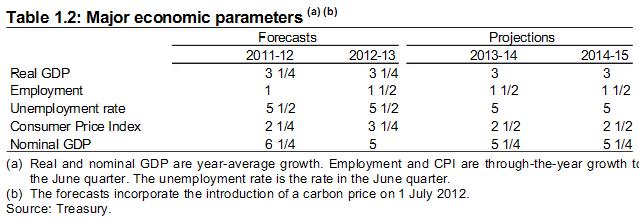
The two indicators I’m going to focus on are employment and GDP, as well as touch on commodity prices. First employment. For me, the signs are everywhere that a jump in unemployment is imminent. I’m not talking about a GFC slide, but in my view, we are talking about considerably more than the .25% that the MYEFO forecasts. Every employment indicator I track was worse in November than October, with the exception of the official ABS figures. If you look at the breakdown of where the jobs will be lost, it is in the slow states that are dominated by services industries that rely on consumer demand. With credit growth insipid, these states are shedding jobs. The recent DEEWR job ads survey says it all:
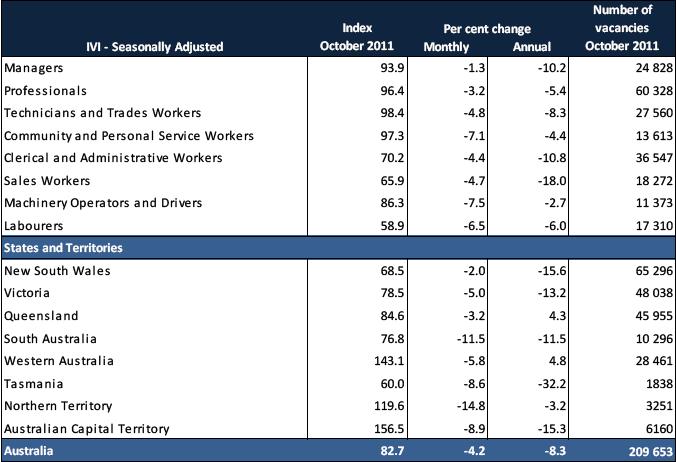
Look at the annual changes in jobs advertised in the big states. The mining boom simply cannot soak up these jobs losses quickly enough.
So, that means lower income tax revenue growth and lower GST revenue growth, as well as higher outlays for the unemployed.
The MYEFO GDP projections are even less convincing. The Australian economy grew 1.3% in the 2010/11 year. Sure we lost a point or so on the floods (but have gotten some of that back in reconstruction). But even so, there is an underlying funk in the consumer demand dimensions of the economy and a high currency that together are severely inhibiting growth. Take a look at these few charts of GDP trends:
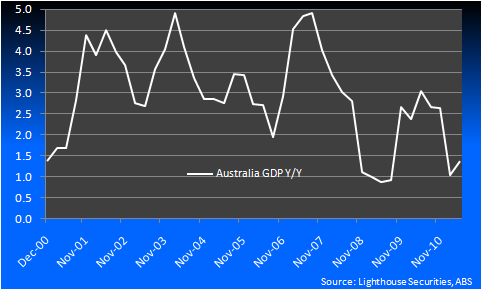
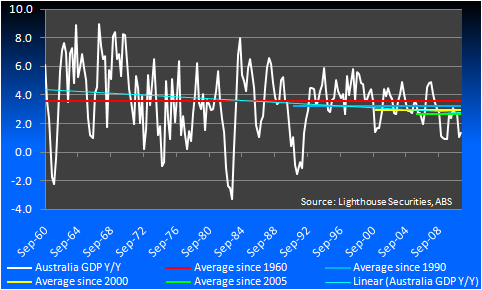
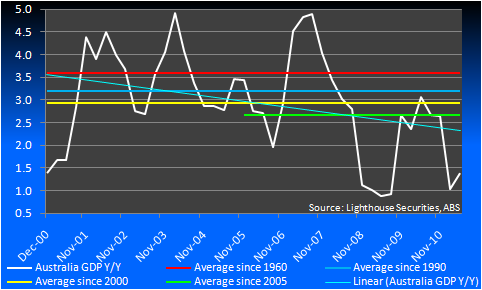
Blind Freddy can see that the trend in Australian growth is slowly sinking towards 2%. It’s some combination of falling productivity, falling credit growth and structural adjustments but it is a fact that it’s real and entrenched. Where are we going to find 3.25% growth for the next two years in a credit hostile world?
Finally, tipping the MYEFO forecasts towards fiction is its assessment of commodity prices:
Looking beyond these near-term movements, the medium-term outlook is for Australia’s terms of trade to decline as the global supply of iron ore and coal increases. Still, the rapid pace of economic development in emerging Asia, and the prospect that strong resources-intensive investment in China and India will continue for many years to come, underpin expectations that the decline in the terms of trade will be gradual. Australia’s terms of trade are forecast to rise 1¾ per cent in 2011-12, before declining 5¼ per cent in 2012-13. The medium-term projections assume that Australia’s terms of trade will decline by a further 20 per cent over the subsequent 15 year period.
By my calculations, coal and iron ore (which make up 50% of the TOT) are set to deliver a 1o% blow to the TOT this year at current prices. And I expect them to fall further. Treasury doesn’t:
Australia’s economic growth outlook is underpinned by the strong prospects for the resources sector, notwithstanding recent declines in commodity prices. Global prices for Australia’s key non-rural commodity exports have declined since early September, coinciding with falls in broader commodities markets, strong growth in supply and a recent easing of global steel production. However, by the end of October, prices appeared to have fallen more than fundamentals would suggest. Iron ore prices have since increased and it is anticipated they will regain further ground over coming months. Notwithstanding recent volatility, coal and iron ore prices remain at high levels and production remains highly profitable for mining companies operating in Australia.
I can only assume that the boffins are expecting an imminent Chinese stimulus. Which seems to be the case:
Given the poor outlook for Europe, sustaining the global recovery in the period ahead will rely primarily on the United States and China, the two largest economies in the world.
Give me one of whatever they’re having.
Despite this, however, with Fitch upgrading our sovereign rating to AAA today, you have to say someone is doing something right going into the latest round global economic turmoil.

